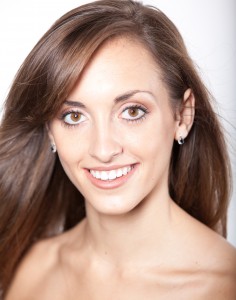
by Cara Marie Gary
July began my third season with The Joffrey Ballet.
There was no easing into rehearsals when we came back from our summer break. Role responsibility was posted and we started full force with learning Christopher Wheeldon’s Swan Lake. Répétiteur Jason Fowler and our ballet masters spent several weeks teaching us the choreography for this four-act ballet. An average day consisted of me arriving at the Joffrey Tower around 9:00am and leaving around 6:45pm.
I like to arrive early to change, fix my hair, sign up for physical therapy and stretch. When preparing for a strenuous full-length ballet, it is important to take class in order to warm up properly before rehearsal. I take class from 9:45am to 11:15am to help improve my technique and build stamina. I then readjust my pointe shoes, grab a rehearsal tutu and head back into Studio A for a three-hour Swan Lake Act II and IV rehearsal. After an hour lunch break, I come back for three more hours of Swan Lake Act I and III rehearsal. My rehearsal day ends by 6:30pm.
My favorite moment during the rehearsal process was when Mr. Wheeldon came to Chicago to work with the company for two weeks. When a choreographer is in the room it changes the dynamic of a rehearsal. They have a unique ability to disclose their artistic vision for the piece they’ve created in a way that is different from a répétiteur or ballet master. Working with a choreographer is a special time that allows dancers to gain new insight about the intentions behind certain movements. When dancers have a better understanding of the choreographer’s vision, it challenges us to strive towards achieving this goal.
Christopher Wheeldon’s visit to a Degas exhibit at the Philadelphia Art Museum inspired this version of Swan Lake. It is differs from other versions in that it is a ballet-within-a-ballet. Act I is set in a ballet studio that appears similar to Degas’ paintings. It begins with dancers entering a studio before rehearsal.
Mr. Wheeldon brought pictures of Degas’ dancers in to show us how we should look during our first entrance into the studio. The Degas paintings come to life as we enter the stage and pause with a statue-like elegance. Some girls enter with warmup shawls and pause to fix their shoes. I enter with my hair completely down and have twenty-five seconds to put it up into a french twist!
Later as the full company arrives, we switch into “rehearsal mode” and begin practicing the production of Swan Lake. Degas’ paintings often have mysterious black-hatted figures hiding in the shadows. Research revealed that these men were aboneés of the Paris Opera Ballet who sponsored productions–and expected more from the dancers. There is a mysterious patron who is introduced to the ballerinas. The man portraying Prince Seigfried is disturbed by the patron’s power over the ballerinas. As the rehearsal concludes, the dancer playing Siegfried stays behind to continue rehearsing alone.
This version eliminates an intermission and the story transitions immediately to Act II. The studio windows fly open and the setting transforms into a lake. The patron from earlier reappears as Von Rothbart and the swans enter through the windows of the studios. In traditional corps work, the dancer is encouraged to blend in so they dance as one. Sometimes individuality can get lost in this near clinical approach and, although impressive, this can sometimes leave an audience emotionally unfulfilled.
In Mr. Wheeldon’s Swan Lake, we’ve been encouraged to emote and dance as if we were all Odette. Giving the corps dancers this type of freedom is not usually found in classical ballet. The challenge that is given to us is to keep our patterns clear and our lines clean, while indulging in the drama and extremity of the movement. He also stressed his desire for the swans to use more port de bras. His choreography requires more of a circular motion of the arms and a rounding contraction of the shoulders. He wants us to break the classical boundaries and explore moving in larger, sweeping motions. We’re challenged to show more drama with our movements and expressions.
In Act III we return to so called “reality” and in our Degas personas we put on a gala for our patrons. In this act, Mr. Wheeldon has played with the music somewhat, and pieces that are traditionally used for specific dances are transformed into new ideas. One example of this is the pas de quatre’s female variation, which is danced to a piece of music traditionally used for one of Odile’s solos. In evolving and tailoring his ballet for The Joffrey Ballet, Mr. Wheeldon was inspired one day to re-choreograph this dance for the two females. It has very quick footwork with a tricky cannon in the middle of the variation. The women must be completely synchronized or the intricate quality of the movement is lost. Learning something that has already been done is one thing, but to have a brand new dance created while you’re in the room is always a special and unique experience. Act III also includes a Russian dance, Spanish dance, Czardas, and Can-Can–as well as Prince Siegfried’s proclamation of love after the fierce and sensual Black Swan pas de deux.
In Act IV we return to the lake. The corps de ballet again breaks with the traditional version and has more dancing in this act. We grieve with Odette and share in her anger at Von Rothbart for tricking Prince Siegfried into proclaiming his love for Odile instead of our Swan Queen. In this version our swans run and leap in complicated patterns, at times mimicking the flight patterns of birds. We use every inch of the stage to convey the tragedy of this magnificent story while seeking revenge against the evil Von Rothbart. The swans dissolve back into the prince’s imagination and our story finishes the way it began–with Degas’ ballerinas back in the studio.
Mr. Wheeldon challenges us to embrace storytelling. He wants us to find a purpose in every moment we are on stage. He stresses how important every role is in portraying a complex fantasy, and I look forward to collaborating with my fellow dancers to paint a story that will captivate the audience in a memorable way.
The Joffrey Ballet and Chicago premiere of Christopher Wheeldon’s Swan Lake © runs October 15-26 at the Auditorium Theatre of Roosevelt University, 50 E. Congress Pkwy., Chicago. Tickets are $32 – $179. To purchase tickets, call 800.982.2787 or visit Joffrey.org/swanlake.

Contributor Cara Marie Gary is a native of Belton, South Carolina. She joined The Joffrey Ballet in July 2012. Prior to joining The Joffrey Ballet, Ms. Gary danced with American Ballet Theatre’s ABTII and was an apprentice with Orlando Ballet. Ms. Gary began her formal ballet training at International Ballet Academy in Greer, South Carolina, under Hennadii Bespechnyi and Vlada Kvsselova. Ms. Gary received additional training at summer intensives with American Ballet Theatre, Brianskv Saratoga Ballet Center, Ukrainian Academy of Dance South Carolina Governors School, Ballet Spartanburg, and Chautauqua Institution. Ms. Gary graduated with honors from Belton-Honea Path High School and is currently pursuing a Business Administration degree online through North Greenville University.
In 2010, Ms. Gary was a competitor in the IX USA International Ballet Competition held in Jackson, Mississippi. She was a top twelve finalist in the Youth America Grand Prix National Finals in 2008 and 2009. She also received the overall Grand Prix Award in the 2009 YAGP regional semi-finals. In 2006, she was awarded a Diploma of Laureate at the VI Serge Lifar International Ballet Competition held in Kiev, Ukraine.
Ms. Gary has had the opportunity to tour throughout the United States and Europe. Ms. Gary has performed the title role in classical ballets such as The Nutcracker, La Sylphide, Don Quixote, Paquita, Markitanka pas de six, and Coppelia. Her repertoire with ABT II includes roles in the Flame of Paris pas de deux, Jerome Robbins’ Interplay, Antony Tudor’s Continuo, George Balanchine’s Allegro Brillante and Stars and Stripes pas de deux, Jessica Lang’s Vivace Motifs, Roger Vanfleteren’s Pavlovsk, Jodi Gate’s A Taste of Sweet Velvet, Aszure Barton’s Barbara, and Edward Liang’s Ballo Per Sei. Ms. Gary has performed roles in new choreography by Robert Hill. Her repertoire with Orlando Ballet also consists of Sleeping Beauty, The Nutcracker, and Swan Lake.




